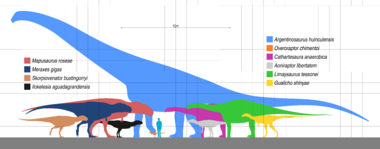Biology:Meraxes
| Meraxes | |
|---|---|

| |
| Reconstructed skull | |
| Scientific classification | |
| Domain: | Eukaryota |
| Kingdom: | Animalia |
| Phylum: | Chordata |
| Clade: | Dinosauria |
| Clade: | Saurischia |
| Clade: | Theropoda |
| Family: | †Carcharodontosauridae |
| Tribe: | †Giganotosaurini |
| Genus: | †Meraxes Canale et al., 2022 |
| Species: | †M. gigas
|
| Binomial name | |
| †Meraxes gigas Canale et al., 2022
| |
Meraxes is a genus of large carcharodontosaurid theropod dinosaur from the Late Cretaceous Huincul Formation of Patagonia, Argentina . The genus contains a single species, Meraxes gigas.[1]
Discovery and naming
The holotype of Meraxes, MMCh-PV 65, was discovered in 2012. Known from a nearly complete skull, pectoral and pelvic elements, partial forelimbs, complete hindlimbs, fragmentary ribs and cervical and dorsal vertebrae, a sacrum, and several complete caudal vertebrae, it represents the most complete carcharodontosaurid skeleton known from the Southern Hemisphere.[1] The specimen was referred to as the "Campanas carcharodontosaurid" before its description as a new species in 2022.[2]
Meraxes gigas was described in 2022 by Canale et al. based on these remains. The generic name, "Meraxes", honors a dragon ridden by Queen Rhaenys Targaryen in the George R. R. Martin novel series, A Song of Ice and Fire. The specific name, "gigas", means "giant" in Greek, in reference to its large size.[1]
Description
Meraxes is one of the largest theropods, weighing approximately 4.26 metric tons (4.70 short tons).[1] Henderson (2023) listed a body length estimate of 9–10 metres (30–33 ft), referencing Canale et al. (2022), but also estimated a body length of 10.2–11.6 metres (33–38 ft) using the pelvic area.[3] Its skull is 1.27 m (4.2 ft) long, similar to that of Acrocanthosaurus, which has a skull length of 1.23–1.29 m (4.0–4.2 ft).[1][4] The shapes and proportions of various bones, including the skull, scapula, metacarpals, ischial shaft, and foot, indicate that Meraxes and Acrocanthosaurus had similar proportions and body size. Meraxes possessed reduced forelimbs, an instance of convergent evolution that occurred independently in four different lineages: Carcharodontosauridae, Abelisauridae, Tyrannosauridae, and Alvarezsauridae. Additionally, the second toes possess an enlarged claw, almost twice as long as the claw on the fourth toe.[1]
Osteohistological analysis of the holotype suggests the individual could have been between 39 and 53 years old when it died, having reached skeletal maturity approximately 4 years prior to its death (between 35 and 49 years old), making it the longest-lived non-avian theropod currently known. Meraxes was determined to have grown to large size by extending its growth period (hypermorphosis), rather than increasing its relative growth rate (acceleration) through development as in Tyrannosaurus, to which it was compared.[1][2]
Classification
Canale et al. (2022) recovered Meraxes as the earliest diverging member of the tribe Giganotosaurini within the Carcharodontosauridae. The cladogram results of their phylogenetic analyses are displayed in the cladogram below:[1]
| Carcharodontosauridae |
| |||||||||||||||||||||||||||||||||||||||||||||||||||||||||
Paleoenvironment
The fossil remains of Meraxes were recovered from the Huincul Formation. A substantial number of taxa are known to have inhabited this paleoenvironment. Theropods from the formation include the paravian Overoraptor, the elaphrosaurine Huinculsaurus, the abelisaurs Skorpiovenator, Tralkasaurus, and Ilokelesia, the megaraptoran Aoniraptor, and the fellow giant carcharodontosaurid Mapusaurus.[5][6] Meraxes was found in an older rock layer than Mapusaurus, so it is unlikely they coexisted.[1] The herbivores of the area are represented by the rebbachisaurid sauropods Cathartesaura and Limaysaurus, the titanosaurs Argentinosaurus, Choconsaurus, and Chucarosaurus, and indeterminate iguanodonts.[7][8][9]
References
- ↑ 1.0 1.1 1.2 1.3 1.4 1.5 1.6 1.7 1.8 Canale, Juan I.; Apesteguía, Sebastián; Gallina, Pablo A.; Mitchell, Jonathan; Smith, Nathan D.; Cullen, Thomas M.; Shinya, Akiko; Haluza, Alejandro et al. (July 2022). "New giant carnivorous dinosaur reveals convergent evolutionary trends in theropod arm reduction". Current Biology 32 (14): 3195–3202.e5. doi:10.1016/j.cub.2022.05.057. PMID 35803271.
- ↑ 2.0 2.1 Cullen, Thomas M.; Canale, Juan I.; Apesteguía, Sebastián; Smith, Nathan D.; Hu, Dongyu; Makovicky, Peter J. (2020-11-25). "Osteohistological analyses reveal diverse strategies of theropod dinosaur body-size evolution". Proceedings of the Royal Society B: Biological Sciences 287 (1939): 20202258. doi:10.1098/rspb.2020.2258. PMID 33234083.
- ↑ Henderson, Donald M. (2023). "Growth constraints set an upper limit to theropod dinosaur body size". The Science of Nature 110 (1): 4. doi:10.1007/s00114-023-01832-1.
- ↑ Currie, Philip J.; Carpenter, Kenneth (2000). "A new specimen of Acrocanthosaurus atokensis (Theropoda, Dinosauria) from the Lower Cretaceous Antlers Formation (Lower Cretaceous, Aptian) of Oklahoma, USA". Geodiversitas 22 (2): 207–246. https://www.researchgate.net/publication/40662847_A_new_specimen_of_Acrocanthosaurus_atokensis_Theropoda_Dinosauria_from_the_Lower_Cretaceous_Antlers_Formation_Lower_Cretaceous_Aptian_of_Oklahoma_USA.
- ↑ Matías J. Motta; Federico L. Agnolín; Federico Brissón Egli; Fernando E. Novas (2020). "New theropod dinosaur from the Upper Cretaceous of Patagonia sheds light on the paravian radiation in Gondwana". The Science of Nature 107 (3): Article number 24. doi:10.1007/s00114-020-01682-1. PMID 32468191. Bibcode: 2020SciNa.107...24M.
- ↑ Cerroni, M.A.; Motta, M.J.; Agnolín, F.L.; Aranciaga Rolando, A.M.; Brissón Egli, F.; Novas, F.E. (2020). "A new abelisaurid from the Huincul Formation (Cenomanian-Turonian; Upper Cretaceous) of Río Negro province, Argentina". Journal of South American Earth Sciences 98: 102445. doi:10.1016/j.jsames.2019.102445. Bibcode: 2020JSAES..9802445C.
- ↑ Calvo, Jorge O.; Salgado, Leonardo (1995). "Rebbachisaurus tessonei sp. nov. a new Sauropoda from the Albian-Cenomanian of Argentina; new evidence on the origin of the Diplodocidae". Gaia 11: 13–33. https://www.dinochecker.com/papers/Calvo%2BSalgado-%5B1995%5D-Rebbachisaurus-tessonei.pdf.
- ↑ Baiano, Mattia A.; Coria, Rodolfo A.; Cau, Andrea (June 2020). "A new abelisauroid (Dinosauria: Theropoda) from the Huincul Formation (lower Upper Cretaceous, Neuquén Basin) of Patagonia, Argentina". Cretaceous Research 110: 104408. doi:10.1016/j.cretres.2020.104408.
- ↑ Agnolin, Federico L.; Gonzalez Riga, Bernardo J.; Aranciaga Rolando, Alexis M.; Rozadilla, Sebastián; Motta, Matías J.; Chimento, Nicolás R.; Novas, Fernando E. (2023-02-02). "A new giant titanosaur (Dinosauria, Sauropoda) from the Upper Cretaceous of Northwestern Patagonia, Argentina" (in en). Cretaceous Research: 105487. doi:10.1016/j.cretres.2023.105487. ISSN 0195-6671. https://www.sciencedirect.com/science/article/pii/S0195667123000150.
Wikidata ☰ Q112966897 entry
 |





